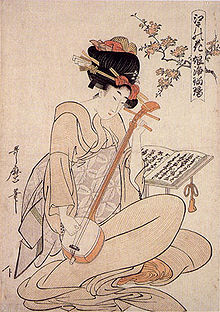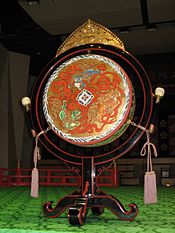- Traditional Japanese musical instruments
-
 Kitagawa Utamaro, "Flowers of Edo: Young Woman's Narrative Chanting to the Shamisen", ca. 1880
Kitagawa Utamaro, "Flowers of Edo: Young Woman's Narrative Chanting to the Shamisen", ca. 1880
Traditional Japanese musical instruments comprise a wide range of string, wind, and percussion instruments.
Contents
String
Plucked
- Biwa (琵琶) - pear-shaped lute
- Ichigenkin (kanji: 一絃琴) - one-string zither
- Koto (琴, 箏) - long zither
- Junanagen (十七絃) - 17-stringed zither
- Taishogoto (大正琴) - zither with metal strings and keys
- Kugo (箜篌) - an angled harp used in ancient times and recently revived
- Sanshin (三線) - three-string banjo from Okinawa
- Shamisen (三味線) - A banjo-like lute with three strings, the shamisen was brought to Japan from China in the 16th century. Popular in Edo's pleasure districts, the shamisen was often used in Kabuki theater. Made from red sandalwood and ranging from 1.1 to 1.4 meters long, the shamisen has ivory pegs, strings made from twisted silk, and a belly covered in cat or dog skin. The strings, which are of different thickness, are plucked or struck with a tortoise shell pick.
- Yamatogoto (大和琴) - ancient long zither; also called wagon (和琴)
- Tonkori (トンコリ) - plucked instrument used by the Ainu of Hokkaidō
Bowed
- bowed lute with three (or, more rarely, four) strings and a skin-covered body
Wind
Flutes
Japanese flutes are called Fue. there are eight different flutes
- Hocchiku (法竹) - vertical bamboo flute
- Nohkan (能管) - transverse bamboo flute used for noh theater
- Ryūteki (龍笛) - transverse bamboo flute used for gagaku
- Kagurabue (神楽笛) - transverse bamboo flute used for mi-kagura (御神楽, Shinto ritual music)
- Komabue (高麗笛) - transverse bamboo flute used for komagaku; similar to the ryūteki
- Shakuhachi (尺八) - vertical bamboo flute used for Zen meditation
- Shinobue (篠笛) - transverse folk bamboo flute
- Tsuchibue (hiragana: つちぶえ; kanji: 土笛; literally "earthen flute") - globular flute made from clay
Reeded Instruments
Free reed mouth organs
Horns
- Horagai (法螺貝) - seashell horn; also called jinkai (陣貝)
Percussion
Drums
- Kakko (羯鼓) - small drum used in gagaku
- Taiko (太鼓), literally "great drum"
- Tsuri-daiko (釣太鼓) - drum on a stand with ornately painted head, played with a padded stick
- Ikko - small, ornately decorated hourglass-shaped drum
- San-no-tsuzumi (三の鼓), hourglass-shaped double-headed drum; struck only on one side
- Den-den daiko (でんでん太鼓) - pellet drum, used as a children's toy
Other
- Hyōshigi (拍子木) - wooden or bamboo clappers
- Mokugyo (木魚) - woodblock carved in the shape of a fish, struck with a wooden stick; often used in Buddhist chanting
- Shōko (鉦鼓) - small gong used in gagaku; struck with two horn beaters
- Sasara (ささら) - clapper made from wooden slats connected by a rope or cord
- Ita-sasara (板ささら) - clapper made from wooden slats connected by a rope or cord
- Bin-sasara (編木, 板ささら; also spelled bin-zasara) - clapper made from wooden slats connected by a rope or cord
- Kokiriko (筑子, こきりこ) - many people confuse the kokiriko with the sasara and sasara are often sold outside Japan under the name kokiriko. In fact, the kokiriko is a pair of sticks which are beaten together slowly and rhythmically.
- Kagura suzu - hand-held bell tree with three tiers of pellet bells
- Kane (鉦) - small flat gong
- Shakubyoshi (also called shaku) - clapper made from a pair of flat wooden sticks
Other
- Mukkuri (ムックリ) - jaw harp used by the Ainu people
- Koukin (口琴) - general name for the jaw harp, in Edo period also called Biyabon (びやぼん)
See also
Music of Japan Traditional music 
Modern music
(20th-21st century)Enka • Eurobeat • Group Sounds • Hardcore • Hip hop • Pop • Technopop/J-tek • Ska • Noise • Jazz • Kayōkyoku • Onkyokei • Reggae • Rōkyoku • Ryūkōka • Shibuya-kei • Visual kei (Nagoya kei)Ethnic and regional music Ainu music (Rekuhkara) • Ryukyu IslandsFestivals B-Boy Park • Concert on the Rock • Firefox Rock Festival • Fuji Rock Festival • Heart-Aid Shisen • Independence-D • Live under the sky • Loud Park Festival • Mount Fuji Jazz Festival • Newport Jazz Festival in Madarao • Rising Sun Rock Festival • Rock in Japan Festival • Saito Kinen Festival Matsumoto • Songs Day • Summer Sonic Festival • Tokyo Music Festival • Yamaha Music Festival • Yamaha Popular Song ContestCharts Japan Hot 100 • Oricon • RIAJ Digital Track ChartNational anthem "Kimigayo"Other topics Categories:- Japanese musical instruments
- Japanese music lists
- Japanese traditional music
Wikimedia Foundation. 2010.

